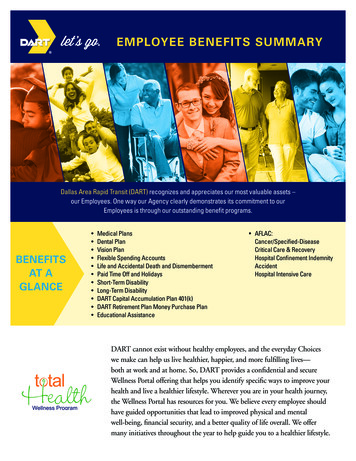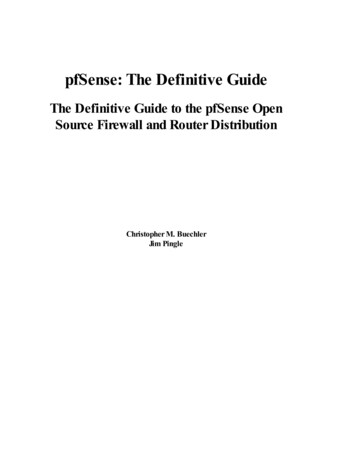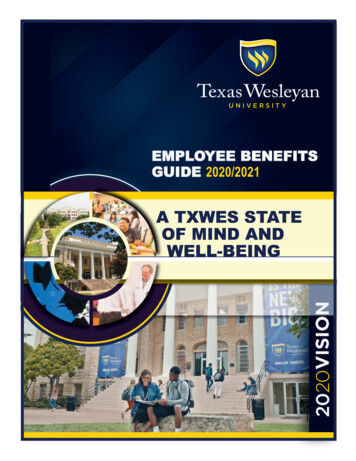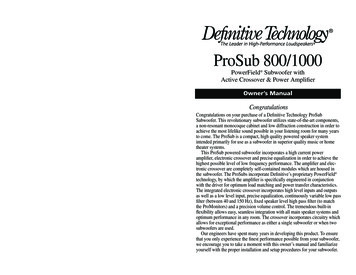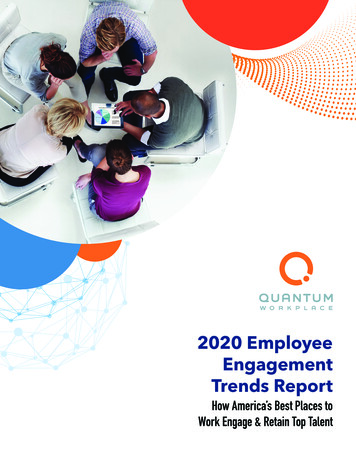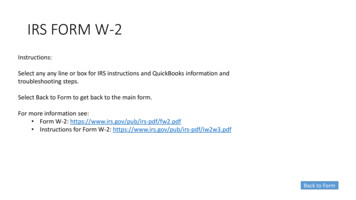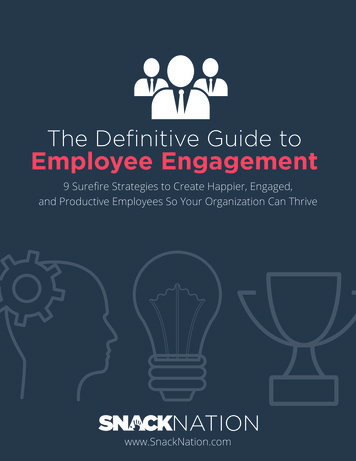
Transcription
The Definitive Guide toEmployee Engagement9 Surefire Strategies to Create Happier, Engaged,and Productive Employees So Your Organization Can Thrivewww.SnackNation.com/ The Definitive Guide to Employee Engagement1
IndexIntroduction4HOW TO USE THIS GUIDEChapter 17WHY EMPLOYEE ENGAGEMENT MATTERSChapter 213THE 9 PILLARS OF EMPLOYEE ENGAGEMENTChapter 314VALUES & PURPOSE (THE WHY)Chapter 424COMMUNICATIONChapter 534HEALTH AND WELLNESSChapter 644WORKSPACE AND ENVIRONMENTChapter 752WELL-DEFINED ROLESChapter 857RELATIONSHIPS WITH COLLEAGUESChapter 965RECOGNITION AND INCENTIVESChapter 1069AMAZING MANAGERSChapter 1177PERSONAL GROWTH AND DEVELOPMENTChapter 1285BRINGING IT ALL TOGETHER, EE STRATEGIES IN ACTIONAppendix92WHAT YOU CAN DO TODAY/ The Definitive Guide to Employee Engagement2
ABOUT THE AUTHORSSean KellyCEO, SnackNationChairman, Association of WorkplaceEngagement (AWE)Sean Kelly is the CEO of SnackNation, a healthyoffice snack delivery service that makeshealthy snacking fun, life more productive,and workplaces awesome. Sean is alsothe Chairman of AwesomeOffice.org, anassociation dedicated to helping companiesmaximize employee engagement, productivityand wellbeing, and the host of the Awesome Office Show, a top 50 businesspodcast on iTunes. Sean holds a degree in Biomedical Engineering fromColumbia University, and has been named to Forbes’ 30 Under 30 and MostPromising CEOs Under 35 lists.Follow Sean on Twitter: @SeanpkJeff MurphyDirector of Communications, SnackNationJeff Murphy is the Director ofCommunications for SnackNation, where heoversees marketing content strategy, and theproducer of the Awesome Office Show. Heis also an avid writer and surfer, and earneddual degrees in English and Political Sciencefrom the University of California at Berkeley.Follow Jeff on Twitter: @J3ffmurphy/ The Definitive Guide to Employee Engagement3
IntroductionFirst, congratulations are in order.Congratulations for embracing the idea of employee engagement and for takingthe first step on a journey towards creating a healthier, happier, more creative, andmore productive workforce. Like exercise, where half the battle is just showing upto the gym, the key to creating a more engaged team is simply caring about it eachand every day.At SnackNation, engagement is something we think about constantly, both forour own employees and for the companies we serve. It’s why we do what we do.It’s also why we’ve put togetherthis guide - to help you transformyour organization and create anenvironment where your employeescan strive to be their best selves everysingle day.Engagement is a tricky topic. Mostexecutives have heard of it, butfew really understand it. That’s whywe’ve spent tons of time and energy/ The Definitive Guide to Employee Engagement4
INTRODUCTIONcreating The Definitive Guide to Employee Engagement – to help you filter out thenoise and focus on what really matters. Think of this as your one-stop-shop fordeveloping and deploying a powerful employee engagement strategy that willenable you to maximize the energy, creativity, and productivity of your company’swork force, and allow your organization to thrive.We’ve compiled ideas and data from the leading researchers in employeeengagement, as well as case studies and recommended action steps that showwhat these ideas look like in the real world. At the end of this journey, you’ll havethe tools necessary to develop and apply an engagement strategy that fits thespecific needs of your organization.HOW TO USE THIS GUIDEA quick note on how to use this Definitive Guide.The benefits of an engaged workforce are many, and go way beyond the bottomline. Engaged workers are happier, healthier, have a sense of purpose, and leadmore fulfilling lives. The point of this guide is provide you with the tools, knowledge,and know-how to develop and execute a world-class engagement strategy - andreap the benefits for your own organization.We took a two-pronged approach, focusing equally on theory and practice, andincorporating real world examples wherever we could.We start with the basics - in Chapter 1, we define the concept of employeeengagement, tracing how it’s evolved over time, and pinpointing why it’s critical thatyour organization adopts it as a framework for success.Once we’ve defined the concept, we introduce our Nine Pillars of EmployeeEngagement in Chapter 2. After poring over the academic literature, interviewingcountless people-focused executives at some of the most engaged companies inthe country, and drawing from our own experience as an engagement-focusedcompany, we’ve pinpointed nine pillars of employee engagement. These are thenine essential elements that your engagement strategy needs to address, and thatall engagement strategies must touch in order to be successful./ The Definitive Guide to Employee Engagement5
INTRODUCTIONFrom there, we dive into each concept in depth, dedicating a chapter to each, andfurther clarifying the basic ideas with the latest, most relevant theoretical research.Theory is great, but we’re firm believers that ideas aren’t worth much until they’reapplied. We wanted this guide to be actionable. To this end, each pillar chapterfeatures an example or full blown case study of the theories discussed, as wellas specific steps you can take today to help put these ideas into action. To makeit easy, you’ll find these Action Steps at the close of every pillar chapter (3-11),indicated by the symbol.Lastly, we bring everything together in the final chapter, with a sample employeeengagement strategy that integrates everything you’ll have learned in the previouschapters. This last section is meant to inspire you to develop an ideal engagementstrategy for your organization. Remember that engagement is not a one-size-fits-allsolution. Every organization is different, with different goals, values, and challenges.We recommend that you use our strategy as a guide, and then tailor it to fit thespecific needs of your unique team.So, again, congratulations on taking that first step. Now let’s take the next one,shall we?/ The Definitive Guide to Employee Engagement6
Chapter 1WHAT IS EMPLOYEE ENGAGEMENT?Employee Engagement. We’ve all heard of it. Some of us may even know that it’simportant. But why is it important? And before we even get into that, what exactly is it?Unfortunately, defining the concept isn’t as simple as it sounds, and there seems tobe as many definitions as there are so-called employee engagement “experts.” (Inother words, a lot.)First, it might help to clarify what employee engagement is not. Contrary to popularbelief, employee engagement is not the same thing as job satisfaction, nor doesit simply mean job happiness. Believe it or not,individuals can actually be satisfied with their jobsand still be disengaged.Consider the employee (we’ll call him Daryl) whobreezes into the office late each day, leaves early,and still collects a hefty paycheck. In between timespent browsing TMZ.com, checking the lineup/ The Definitive Guide to Employee Engagement7
WHAT IS EMPLOYEE ENGAGEMENT?for his fantasy football team, and answering personal emails and phone calls, hemight do an hour of actual work for his company. Daryl may be satisfied by thisarrangement. He might even be happy with it. (In point of fact, Daryl is downrightgiddy.) But by no means can we say that Daryl is engaged at work.All engaged employees are, to a certain extent, content, but not all contentemployees are engaged. So what’s the difference? The answer lies in performance.It’s not just happiness or satisfaction that matters, but how those emotionsdirectly relate to the individual’s and company’s performance and productivity.As entrepreneur and engagement expert Andre Lavoie points out in a column forEntrepreneur magazine, performance and engagement are intrinsically related:“A good leader values employee happiness. A greatleader values the employee engagement that resultsfrom that happiness. That is what employee engagementis, after all - the degree to which an employee’s feelingsabout their job (and boss) influences their willingness tolearn and perform at work.”Experts have also used the concept of “discretionary effort” to help defineengagement, referring to the amount of extra time that employees are willingto put in at work, above and beyond what’s expected. To us, this description fallsshort, since an employee may be donating her discretionary time, but because shefeels intense pressure, not because she’s inspired by a sense of purposeor fulfillment.For our purposes, the definition offered by Emma Bridger (which in turnborrows heavily from ideas first proposed by John Smythe in his book “The ChiefEngagement Officer”), works best:“Employee engagement is[t]he extent to which people arepersonally involved in the success of a business.”Why do we like this definition? Well, besides the fact that it’s clear and concise,/ The Definitive Guide to Employee Engagement8
WHAT IS EMPLOYEE ENGAGEMENT?this formulation works because it captures both the performance aspect inherentto engagement, as well as the oft-overlooked (but equally critical) emotionalcomponent. Engaged employees will go the extra mile because they feel a strongemotional connection to the organization. They want their businesses to succeedbecause they identify with their company’s mission, purpose, or values on apersonal level.An engaged workforce is not unlikea D1 college sports team, in whichteammates bond through shared goals,commons experiences, and the triumphsand struggles of a long and sometimeschallenging season. Often, the bondsformed between teammates, theircoaches, and their schools last a lifetime,and benefit the individuals in unexpectedways for years to come.While this might sound like the definition of “the soft stuff,” believe it or not, thispersonal connection can actually be measured by an employee’s willingness torecommend their company as a good place to work or do business.Engaged employees go that extra mile because success is personal for them. Aswe’ll uncover, these two factors - emotional connection and performance - arethe two most important concepts in understanding engagement and creatingengagement strategies that work.To further drive home the point, engaged employees also share a number ofcommon characteristics:Engaged employees are self-guidedhave well defined rolesunderstand their contribution to the organizationinvest in personal and professional developmentfeel connected to their team and the larger organization/ The Definitive Guide to Employee Engagement9
WHAT IS EMPLOYEE ENGAGEMENT?WHY EMPLOYEE ENGAGEMENT?If you care about engagement, you’re not alone. According to Deloitte, retentionand engagement has risen to the second most thought about topic in the minds ofbusiness leaders, second only to the challenge of building global leadership.So why all this focus on engagement?Believe it or not, we’re all in the business of employee engagement.Consider this: engagement affects every person inside your organization, and everyperson in-side your organization affects your bottom line. Your employees are yourfirst customers, and by far the most important.This idea is best expressed in the Service-Profit Chain, a model first theorized bya group of Harvard Researchers in the nineteen nineties that establishes linksbetween profitability, customer loyalty, and employee engagement. The formulationtraces profitability to the value created by satisfied, loyal, and productiveemployees. Businesses, the theory goes, must create the conditions for satisfiedand engaged employees, in order to create valuable, loyalty-inspiring experiencesfor customers, which will ultimately drive profits.The best business leaders know that an engaged workforce can drive innovation,increase performance and raise productivity, grow the organization, improvecustomer care, and foster loyalty, both internally and externally.The Costs of DisengagementThere’s empirical data to back up the importance of engagement as well. Accordingto the latest research, non-engaged employees cost this country billions./ The Definitive Guide to Employee Engagement10
WHAT IS EMPLOYEE ENGAGEMENT?Research firm Gallup recently reported that an astonishing 68.5% of U.S.employees are not engaged in their current roles. Within that group, 17.5% of theworkforce characterize themselves as actively disengaged, which means that theyare actively working to undermine the success of their own companies. (Let that lastidea sink in for a moment.) What’s worse, actively disengaged workers are notonly unhappy and unproductive themselves, but their negativity actually rubsoff on the people around them, turning potentially engaged employees intonon-engaged workers.68.5% of U.S. employees are not engaged in their current role.According to their 2013 State of the American Workplace report, Gallup estimatesthat active disengagement costs American companies 450 - 550 billion in lostproductivity each year.Perhaps not surprisingly, Millennials are the least engaged segment of theworkforce, with only 28.9% identifying as engaged, compared to 32.2% forGeneration X-ers, and 42.2% for so-called “Traditionalists.” Raised on technologyand with high expectations for aworkplace that delivers seamlessand fulfilling work-life integration,these younger employees are oftendisappointed by the work environmentsin which they find themselves.Not your problem? Think again.This data likely means that unlessemployers adopt a proactive strategy,engagement will decrease as Baby Boomers and Traditionalists retire and theseyounger workers make up an increasing percentage of the workforce. In early2015, for the first time ever, Millennials became the largest demographic in theworkplace, and by 2020 they’re expected to make-up more than 50% of all workers.Times are certainly changing, and your company must too./ The Definitive Guide to Employee Engagement11
WHAT IS EMPLOYEE ENGAGEMENT?Worldwide, the numbers are even more dismal. According to their 2013 global survey,Gallup found that only a paltry 13% of workers were engaged, and 24% wereactively disengaged. Approximately speaking, this translates to 900 million notengaged and 340 million actively disengaged workers around the globe. Thinkof all the things this potentially productive workforce could accomplish with adifferent mindset!If you still need convincing that engagement matters, try this on for size - researchshows that engaged companies consistently outperform their competition in anumber of categories, including profits, productivity, and retention.There are several factors driving the trend towards a greater emphasis onemployee engagement, chief among them being the shift towards an informationand service economy. In other words, people are more important than ever, and asa result, the role of HR has morphed from a backend administrative function thatmostly focused on hiring and compliance, to a front-and-center strategic role thatmany business leaders now see as critical to the overall success of an enterprise.You simply can’t afford to ignore employee engagement. This isn’t about whether ornot your company will thrive - it’s first and foremost about whether you’ll survive.Trends in HR are driving towards the increasedimportance of Employee Engagement Employee-employer relationship transitioning from paternalisticmodel to partnership Increased demand for work/life balance HR’s greater role in performance and company strategy Increasing focus on selective retention for keeping mission-critical talent Decline in traditional communication, increase in digital Needs of the talent pool driving hiring practices/ The Definitive Guide to Employee Engagement12
Chapter 2THE 9 PILLARS OF EMPLOYEE ENGAGEMENTAs we’ve already seen, employee engagement is complex.Engagement is closely linked to an employee’s emotional connection to his orher company, and how that connection translates to job performance. There aremultiple factors that influence these emotions - trust in leadership, reputation,good managers, quality and frequency of communication, health and wellbeing,the list goes on. Add to that a laundry list of cognitive and skills-related factors. Thedeeper you go, the more confusing employee engagement can seem.With this in mind, we’ve identified nine key areas that every successful employeeengagement strategy needs to address. We call them.The 9 Pillars of Employee Engagement1Values & Purpose (the Why)2Communication4Workspace / Environment5Well-defined Roles7Recognition and Incentives8Buy-in from Managers3Health and Wellness6 Relationship with Colleagues9Personal Growthand DevelopmentNow, let’s take a closer look / The Definitive Guide to Employee Engagement13
Chapter 3VALUES AND PURPOSE(THE “WHY” OF YOUR BRAND)Why a company exists can sometimes be difficult to pin down. What your businessdoes and how it does it - most people in the organization can probably tell you that.But why it exists? That terrain is a little harder to navigate, and often hard to articulate.But, as Simon Sinek demonstrated in his widely referenced TED talk (and subsequentbook), the best brands and most innovative companies start with Why, and let thatdrive their What and How.Let’s be clear - the “Why” of yourbusiness doesn’t refer to goalslike solvency or profitability. It’ssomething deeper. It’s a purpose,a cause, or a belief that drives youforward - the thing that gets you outof bed in the morning. It’s why youdo what you do on a spiritual, sociopolitical, or philosophical level, andit can be wide or narrow in scope.Your Why might be to help peopleachieve something specific, to solvea particular problem for a particularcommunity, to challenge the statusquo, or even to make the world abetter place.As AdoptTogether.org founder Hank Fortener pointed out on the Awesome OfficeShow, human beings are tribal. We have an innate desire to be a part of somethingbigger than ourselves. A sense of purpose is one way of doing that, because itconnects us to a common, higher mission, and inspires us to put the needs ofothers before our own./ The Definitive Guide to Employee Engagement14
VALUES AND PURPOSEArming your employees with a sense of purposeis critical to creating the emotional bond betweenyour employees and their work, and thus boostingtheir engagement. As a recent study from Deloittedemonstrates, how well you communicate yourcompany’s purpose is directly correlated with howengaged your employees are.The most basic expression of the Why of yourbrand should be your mission statement. A mission statement is a clear, concisestatement that encapsulates the Why of your brand. Here are a few examples ofmission statements that do a great job of this:Google: organize the world’s information and make it universallyaccessible and useful.Zappos: deliver happiness.TOMS Shoes: help provide shoes, sight, water, safe birth and bullyingprevention services to people in need.Whole Foods: help support the health, well-being, and healing of bothpeople — customers, Team Members, and business organizations ingeneral — and the planet.Teach for America: enlist, develop, and mobilize as many as possible ofour nation’s most promising future leaders to grow and strengthen themovement for educational equity and excellence.SnackNation: make healthy snacking fun, life more productive and youroffice awesome.As you can see, mission statements can vary widely in scope and ambition. Somemission statements, like Google’s, have a direct line of sight to the company’sbusiness. For others - like TOMS Shoes or Zappos - the connection is less obvious.Either way, a good mission statement needs to be a clear, concise articulation ofyour brand’s particular “Why.”/ The Definitive Guide to Employee Engagement15
VALUES AND PURPOSELikewise, a company’s core values are an extension of your “Why,” a way to clarifyand codify your organization’s purpose, as well as the ideal standards, methods,and practices by which you aim to achieve that purpose.Here are some examples of core values that capture and build upon their particular Why: Focus on the user and all else will follow.It’s best to do one thing really, really well.Fast is better than slow.Democracy on the web works.You don’t need to be at your desk to need an answer.You can make money without doing evil.There’s always more information out there.The need for information crosses all borders.You can be serious without a suit.Great just isn’t good enough. Deliver WOW Through ServiceEmbrace and Drive ChangeCreate Fun and A Little WeirdnessBe Adventurous, Creative, and Open-MindedPursue Growth and LearningBuild Open and Honest Relationships With CommunicationBuild a Positive Team and Family SpiritDo More With LessBe Passionate and DeterminedBe Humble Give Sustainably. Give Responsibly.Giving PartnershipsIdentify Communities That Need ShoesGive Shoes That FitHelp Our Shoes Have a Bigger ImpactGive Children Shoes As They GrowWelcome Feedback and Help Us Improve/ The Definitive Guide to Employee Engagement16
VALUES AND PURPOSE Selling the highest quality natural and organic products availableSatisfying and delighting our customersSupporting team member excellence and happinessCreating wealth through profits and growthCaring about our communities and our environmentCreating ongoing win-win partnerships with our suppliersPromoting the health of our stakeholders through healthyeating education Transformational ChangeLeadershipTeamDiversityRespect and Humility Do the right thingServe and inspireCrush it with “Yes!”Be fun and unreasonableSeek perpetual growthCrave and devour challengesInnovate or dieCommunicate authenticallyThe best values provide a framework for achieving the mission using methodsconsistent with the Why of your band, so that employees have a framework thathelps them in planning, decision making, and execution of both daily and bigpicture tasks.Why Values Matter - The Inside-out Effect of CultureSo how do values affect the day in and day out operations of your organization?The answer lies in the inside-out effect of culture.In a functional sense, your organization’s culture is the sum total of the beliefs andbehaviors that guide interactions between employees and other key stakeholders,/ The Definitive Guide to Employee Engagement17
VALUES AND PURPOSEboth internally and externally. Culture manifests in observable things like hours,dress code, benefits, workspace, turnover, hiring, and customer care and satisfaction.But culture is also something less tangible - it’s a feeling or a vibe, the mood andenergy people bring in each day, the language they use, the mindset they adopt,and the methods they use to solve problems.While culture is something that can develop organically over time as your businesschanges or as your company grows, the character of your culture and the pace anddirection of its growth is not accidental. As a leader in the organization, it’s yourresponsibility to be a cultural steward and to set the course of that development.The mission and values are the bedrock for your company’s culture, and are yourbiggest tools for steering your culture in the right direction.So what happens when you don’t get this right?An inconsistent culture can create a disconnect within your organization, which canhave negative consequences for current and potential customers, and cost yourbusiness significantly in the long run. Remember that everything you do as a brand,both internally and externally, carries subtle messages, and inconsistency in these/ The Definitive Guide to Employee Engagement18
VALUES AND PURPOSEmessages can undermine the trust you’ve worked so hard to cultivatewith customers and employees alike. Starting with the Why and working outwardsto the How and What of your brand ensures a consistent message that willpermeate the internal culture, and positively influence the external brand, product,and customer experience.Assessing an internal culture might seem like a daunting task, but often, it’s assimple as a taking a look around and asking some tough questions:Questions to assess the health of your company culture: Do you and your employees socialize outside of work? Do most of your employees have a best friend at the office? Are your employees more likely to accept responsibility fortheir mistakes or pass the blame to others? Are your employees likely to recommend working at yourcompany to a friend? Do you observe any common bad behaviors, like employeesleaving early?According to the most engaged companies, culturebegins long before an employee sets foot in the office,and is built into the hiring process. For passionatecultural vanguards, like Quest Nutrition PresidentTom Bilyeu, culture takes a front seat in the hiringprocess, ahead of even things like job skills or technicalknowledge. He advises managers to approach the hiringprocess as one might approach selecting a spouse.He recently recommended socializing with candidatesprior to making a hiring decision on the Awesome OfficeShow. It’s important for you and others on your team to enjoy hanging out with apotential new team member. In fact, few things are more critical. Good culturesdon’t make a distinction between “work” and “life” – rather, they understand it’s alljust “life.”/ The Definitive Guide to Employee Engagement19
VALUES AND PURPOSEBy prioritizing cultural fit, companies ensure that they maintain their culturalauthenticity, and ensure that they don’t lose sight of the Why of their brand asthey grow.Case Study - ZapposQuadrupling Growth By Cultivating aCulture of WOWFor retail innovator Zappos, the Whyof their brand can be summed up in asingle word - happiness.The concept of delivering happinessis the foundation of the company’sculture and values, and informseverything they do, from the way theyhire, to their famously responsive customer service and free shipping.Founder Tony Hsieh arrived at this concept in a circuitous fashion. Unhappy atLinkExchange, the company he founded and sold for a nine-figure sum backin 1998, he knew he needed a change. After trying his hand at investing in andincubating startups, Hsieh realized his happiness lie in building something from theground up again. Luckily, he soon found himself at the helm of one his investments- a scrappy online footwear business, whose name was inspired by the spanishword for “shoes.” That company was Zappos.Fast forward to early 2000, and Zappos was struggling to stay afloat. Low onfunding and without a proper marketing budget, the company strategically focusedon over-delivering on customer experience as a way to foster word of mouth.This strategy (combined with a shift in consumer sentiment towards online retail)proved to be exactly what the business needed, and Zappos saw explosive growth.Sales hit 32 million in 2002, a 400% increase from the year before.This turn was a watershed for Hsieh. He recalled his experience getting thingsin the mail as child, and the joy it brought, and suddenly it clicked for him. Whilethe product was important, Zappos wasn’t in the shoe business. They were in the/ The Definitive Guide to Employee Engagement20
VALUES AND PURPOSEhappiness business. The company focused on delivering “wow” to their customers,and made extremely attentive customer service and free shipping and returnshallmarks of the brand.And happiness, he found, didn’t have to be mutually exclusive. Customer happinesscould coexist with employee happiness, investor happiness, and even his ownhappiness. It was clear that delivering happiness (on all fronts) was Zappos’overarching mission.With this as his premise, Hsiehthen set about breaking themission into ten core values.Rather than develop them inisolation, he crowd sourcedthe task, inviting the entirecompany to provide suggestions,and eventually arriving at theten values that underpin thecompany’s culture (see above),which include “deliver WOWthrough service,” “do more withless,” and “be humble.”While the organization has grown and evolved over time, happiness remains thefoundation of the culture, in part because of Zappos’ unique hiring and onboardingprocess. As Zappos’ Insight Manager Erica Javellana explains, it all comes down tofit. “Hiring the right people is probably the most important factor,” she says.All potential Zappos employees undergo two separate interviews one for job skills, andanother for cultural fit, the latter of which is viewed as more important than the former.Zappos candidates are also encouraged to socialize with their prospective teams beforethey are hired to see if they get along outside the office, and often with the CEO himself.“We ask all potential hires how they feel about socializing with co-workers,” Javellanasays. If candidates express a desire to keep their business and personal lives separate,that’s a red flag. Ideally, Zappos employees can be the same person in and out of theoffice. “There’s no concept of work-life balance here,” she elaborates. “It’s all just life.”/ The Definitive Guide to Employee Engagement21
VALUES AND PURPOSE“ ”There’s no concept of work-life balance here. It’s alljust life.- Erica Javellana, ZapposTo really drive home the concept of delivering happiness and how important it is tothe business, all newly hired employees (no matter what the job title) go throughthe same four week training process as the call center reps, two weeks of whichis actually spent fielding customer service calls. The point is to understand thebusiness at its most important touchpoint - at the customer level. At the end ofthe training, Zappos new hires are then presented with the option to quit on thespot. Employees who opt to quit are paid for their time and offered a spot bonus(around 2,000). This cash incentive to leave helps weed out any potential mistakesin the hiring process.One of the reasons cultural fit is so important is that
First, it might help to clarify what employee engagement is not. Contrary to popular belief, employee engagement is not the same thing as job satisfaction, nor does it simply mean job happiness. Believe it or not, individuals can actually be satisfied with their jobs and still be disengaged. Consider the employee (we'll call him Daryl) who


